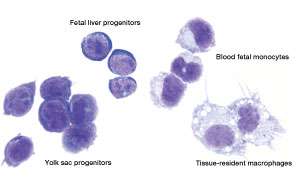Macrophages are shown to originate from two distinct sources during the earliest stages of development in the embryo

A long-held misconception over the origin of macrophages, a type of white blood cell that plays a vital role in development and immunity, has been dismissed. Researchers at A*STAR used state-of-the-art technology to verify that adult tissue-resident macrophages stem from two sources in the early stages of embryonic development.
Macrophages are key components of the body's major organs, including the brain, lungs, and gut. They patrol the body for pathogens, trigger defense mechanisms, and devour damaged cells. They can also turn against the body during various diseases and have been implicated in the growth of cancerous tumors. Therefore, new therapies could either limit or enhance the activity of macrophages, according to the necessary response.
Until 2010, scientists thought that all macrophages were replenished from a continuous supply of monocytes, another form of white blood cell. Then, Florent Ginhoux at the A*STAR Singapore Immunology Network and co-workers proved that microglia, a type of macrophage resident in the brain, actually originates from embryonic yolk sac macrophages.
"Following this discovery, we proposed a systematic study of macrophage development from the embryo onwards, to settle the debate," says Ginhoux. "We employed a 'fate-mapping' technique that allowed us to genetically tag progenitors (developmental precursors derived from stem cells) and follow them from their origins right through to adulthood."
The team developed a mouse model in which fetal macrophage progenitors were tagged to emit fluorescence when triggered by an injection. This allowed the researchers to follow the cells as they moved and differentiated.
"Our biggest challenge was the speed of biological processes during early embryogenesis," states Ginhoux. "Given such a specific target, we had to be incredibly precise, working out the exact timing of the injection, so that we didn't miss any part of the process."
The team's precision paid off. It allowed them to verify that yolk sac macrophages and fetal monocytes derive from early- and late-stage 'erythro-myeloid' progenitor cells. Yolk sac macrophages give rise to microglia, while fetal monocytes colonize other tissues before differentiating into adult tissue-resident macrophages. The macrophages then self-renew throughout life, without the need for a supply of monocytes from the bloodstream.
"The next question to answer is whether the origin of macrophages actually matters," explains Ginhoux. "Essentially it is the 'nature versus nurture' debate – do their origins influence their behavior and functions in later stages of development, both under normal circumstances and in disease? These details will be of crucial importance in the quest to cure cancer, for example."
More information: Guillaume Hoeffel et al. C-Myb+ Erythro-Myeloid Progenitor-Derived Fetal Monocytes Give Rise to Adult Tissue-Resident Macrophages, Immunity (2015). DOI: 10.1016/j.immuni.2015.03.011
F. Ginhoux et al. Fate Mapping Analysis Reveals That Adult Microglia Derive from Primitive Macrophages, Science (2010). DOI: 10.1126/science.1194637



















